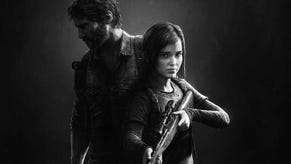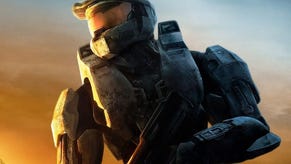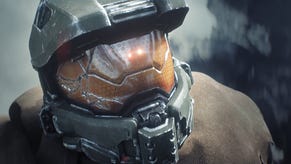Halo 4: Multiplayer and Chief vision shown in CA
343 Industries finally stepped into the Master Chief spotlight in San Francisco last week, showing Halo 4 multiplayer and talking ten-year campaign. This is how the world ends. Again.
"How do we bring people into the IP? It's been a long time since Chief was out there, and there are new gamers coming up that have never experienced Halo. Are there going to be similarities with things we do and any number of other games? There always are."
They look nervous. Halo franchise director Frank O'Connor, creative director Josh Holmes and executive producer Kiki Wolfkill are showing off in-engine work on Halo 4 for the first time at Microsoft's Spring Showcase in San Francisco. The presentation is light on details, but we do see the new Spartan designs and some team multiplayer. The three of them are scanning faces for reaction as we watch a vidoc and see some assets.
They needn't have worried.
Halo 4 will release this year. It's 343's first game in the Halo series since Bungie decided to go multi-platform with Activision. It starts directly after the events of Halo 3 and focuses on Master Chief, and more specifically on fleshing out the super-soldier's character.
In the vidoc, which you can see above, we see Chief getting into a pod saying, "Wake me when you need me." We're told that 343 wants to delve into Chief's character to see what "makes him tick". Halo 4, we're assured will feature a brand new threat, the likes of which the game has never seen.
The new armour designs are excellent. The Spartan IV will feature for the first time; both Chief and the new breed look both slimmed down and beefed up. Everything feels like "grown up" sci-fi, shown to us through dusty sunshine. It reminds me of ponderous future films like Moon.
"There will absolutely be these quiet moments of introspection and character study in the game, but unlike, something like Moon, sometimes you're going to walk around the corner and see a staggeringly huge, bigger than Hollywood set-piece," said O'Connor, speaking to me afterwards.
"You can sometimes do bigger things in video games than you can in movies. I think that in some of the techniques we're using that would be an accurate portrayal of the some of the specific moments, but absolutely not of the whole thing. Especially as we get closer to E3 and the end of year you'll see more of the campaign roll out, and it'll definitely get bigger before it gets smaller."
Wolfkill says Halo 4 will be darker and more sophisticated than the previous games, but later clarifies the remark.
"I think the sophistication comes from a few things," she says. "We revealed some very thin slices. At a higher level, we do want to be able to tell a story, and when I think about sophistication with story, it's being to tell a story that has some themes in it that people can really connect to, beyond the crazy action, which will obviously be always part of Halo, and the heroicism, is to really explore some of these themes.
"I think, from a visual and audio standpoint, all the audio and visual is going towards telling this story, and where we want the player to be emotionally in this story. It definitely has a more cinematic feel. In some cases it will lend itself to what you saw, which is sort of a hazier look. In other instances it may have a very different look, depending on really what we want the player to take away from the scene."
Outside of the high concept of what Halo 4 is aiming to achieve, we see some specific multiplayer. Two maps are revealed - Wraparound and Warhouse, both small arena-style levels - and we see fly-throughs and gameplay itself.
Characters are now fully customizable in multiplayer; Spartans will have load-outs. The big news for Halo online fans is that 343 has decided to include game-changing unlocks in return for level progression, a similar system to that found in Call of Duty, for example.
When I ask Frank and Kiki about the inevitable comparisons to popular military FPS, they're well-prepared.
"It's super-dangerous to chase somebody else's tail, but it's also incredibly dangerous to ignore the changing habits of players, so really rather than looking at the specific games and their functionality, you look at changing and emerging trends for players and what players expect," says Frank.
"That's a really important one to get. You have to at least meet their baseline expectation for various gameplay features. But if you chase someone else's tail and do it badly then it's twice as bad as if you hadn't. We have to make sure that the things we're adding are our things, from our vision, and, yes, they're modern and involved. Halo has such a grand history of, if not revolutionizing the console FPS space, at least pushing it and nudging it forward, and we're going to to try to continue to do that in our own way."
Kiki adds: "There are very few things we could do that wouldn't put us in danger of someone saying, 'Oh, you're chasing this or that.' The reality is that the industry moves in different directions and we have to look at what's best for Halo and what's best for the Halo player.
"Also, how do we bring people into the IP? It's been a long time since Chief was out there, and there are new gamers coming up that have never experienced Halo. Are there going to be similarities with things we do and any number of other games? There always are. But for us it's about what is uniquely Halo, and how do we make that uniquely Halo thing something that's differentiated and fun for the player."
"That dimension of just being a super-soldier that just shoots everything is actually an important dimension for him. It's not actually about getting rid of that at all. It's about layering other characteristics and really just trying to give the player glimpses into some other elements of Chief."
Red vs Blue
Load-outs aren't the only thing about Halo multiplayer that's changed. While the play looks familiar, what with its leaping Spartans and pulse rifles, we don't see any of the new UI. From Frank's comments, there are going to be some sizable differences between Halo 4 multiplay and what's come before.
"One of the things we radically overhauled is how we message information during play," he says.
"If you jump into a game of capture the flag in any FPS, not just Halo, it'll say things like 'flag captured,' and you're like, 'Well, who's flag was captured, and what do i do now?' We took a very high level, philosophical look at that and said, 'If something happened, just tell the player what happened and what to do.'
"Sometimes that can be a verb or tense shift, and sometimes that can just be text, or a picture of a thing. I think if you were playing a mode like capture the flag, for example, and you've never played it before, you'll be aware of what just happened and roughly what you should do about that. I think that's going to be the biggest philosophical difference.
"But I don't think there's going to be less UI, actually. I hope it feels as though there is, and it's less intrusive and it's more informational when it does happen."
Multiplayer will also tell the story of Red vs Blue in Halo 4.
"It's definitely a story element," says O'Connor. "There's a lot of fiction wrapped up in multiplayer now, and there never was before. Multiplayer before was sort of a by-product of how it was built. It was built by a very small sub-team within Bungie for Halo 1, and it grew and grew and grew until it was a star pupil, of course. It was somewhat guerilla. Some of the surreal nature of what you're doing in multiplayer is an outcropping of that original team in that there's limited resources.
"We don't have that any more. The majority of time people are playing is in multiplayer, so you obviously spend a lot more time and focus on that now."
While the multiplayer elements are really the main thrust of the Spring Showcase presentation, though, it isn't what really interests me. This is 343 embarking on a decade-long mission to tell Master Chief's story, to fill out his character and present what will ultimately be one of gaming's most epic stories. It feels so grand. More than 200 people are working on this game, and I can't help feeling there's a danger 343 and Microsoft may be asking too much of the average player. Surely Master Chief is just some dude with a shoot-people-in-the-face complex?
"We're hyper-aware," says Kiki when I ask of the danger of getting ideas above stations. "I made the comment about not wanting the effort to give chief a little more dimension to be disruptive to the player. That dimension of just being a super-soldier that just shoots everything is actually an important dimension for him.
"It's not actually about getting rid of that at all. It's about layering some other characteristics and really just trying to give the player glimpses into some other elements of Chief. Gameplay is always first and foremost. That's the priority and the fun of the experience. But if we can add some depth to that along the way, and really layer in some levels of storytelling throughout, that's really our ultimate goal."
O'Connor adds that it's only the overall plot sketched out for the next three games. Things can change.
"The honest truth is that we don't know exactly what's going to happen in the next game, but we know roughly what's going to happen in the next game and the game after that," he says.
"And there are other experiences beside games. Obviously, we have a big franchise, and there are other places to put pieces of the puzzle. But yeah, we do have an arc. It'll change. The truth is that if we laid out a rigid plan and stuck to it we'd be doing a disservice to ourselves and the creators. It'll change and evolve, but the game that we're putting out this holiday is roughly the game we had in mind about three years ago when we started planning these temples, and in some ways it's bigger and better."
Ultimately, though, 343's continuing mission will be overshadowed in the coming year by its ability to take the baton from Bungie. I almost feel cheap asking the question. Frank, Kiki and the others have been working on this game for some three years, and Frank is Halo's best known face. Several times during the presentation, we hear that Halo 4 has its own voice, that it's its own game. Afterwards, Frank smiles and shrugs.
"The proof is in the pudding," he says. "We won't know really until people play it. We've seen it with past games, where things have either emerged, stars in the gameplay that we didn't think were there, or have flatted out in the gameplay in places we didn't expect. We just won't know the answer until a couple of weeks after the game is released.
"The technology is the easy one, because that's subjective. People will be counting the pixels on Monday, and there objective criteria by which to judge us. The subjective ones? We'll live with the consequences of that, but we're feeling pretty confident, and really optimistic. Everyone's on crunch and will be up until the end of this year, but there's this real optimism as everything comes together, all these pieces that were pipe dreams three years ago are now functioning code or graphics or audio, and now sound or look or feel or play amazing.
"I'm immersing myself in it. I have the soundtrack in my car, and i love it. I'm not doing it for some business purpose; there's no reason for me to listen to the soundtrack all the time, but I love it. It's engaging in that way."
It's early days, but it seems Halo is in safe hands. The developers were scanning our faces in the presentation because they care about the game, about the Chief. Maybe when they're done we'll know enough about him to care too.
Halo 4 launches this holiday season for Xbox 360.










